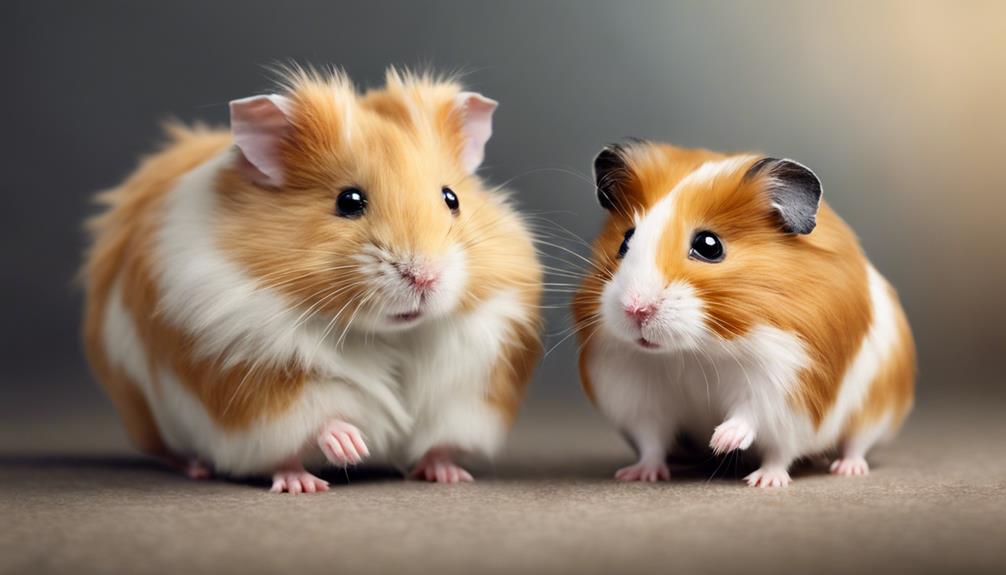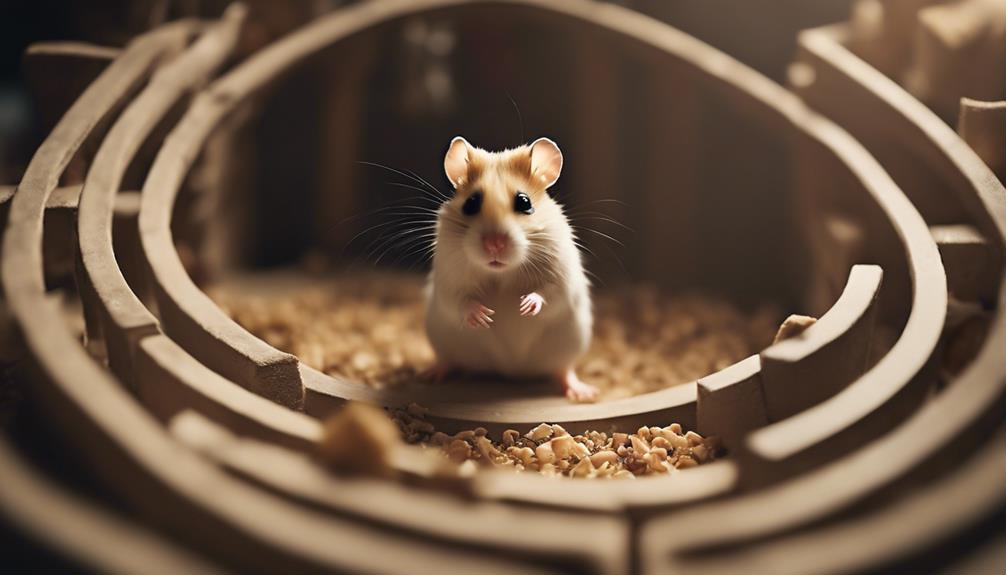What Is the Difference Between Syrian and Dwarf Hamsters?

Syrian hamsters are larger and more solitary. They have different social behaviors and housing requirements.
Dwarf hamsters are smaller and can be kept in pairs or groups. This makes them suitable for different preferences.
Size and Physical Appearance
In comparing Syrian and Dwarf hamsters, one immediately notices a distinct difference in their size and physical appearance. Syrian hamsters, also known as golden hamsters, are notably larger than Dwarf hamsters. Syrian hamsters can grow up to 6-7 inches in length, while Dwarf hamsters typically range from 2-4 inches.
This significant size gap is accompanied by visible disparities in physical characteristics. Syrian hamsters have a more robust build with a plumper body, rounder face, and shorter tail compared to the slender bodies and elongated tails of Dwarf hamsters. Additionally, the Syrian hamster's fur tends to be longer and comes in a wider variety of colors and patterns, whereas Dwarf hamsters have shorter fur and are limited in color variations.
These distinct size and physical appearance differences contribute to the unique charm and appeal of each type of hamster, allowing individuals to choose based on their preferences and living space constraints.
Lifespan and Maturity Rate
Syrian and Dwarf hamsters exhibit differences not only in size and physical appearance but also in their lifespan and maturity rates. When it comes to growth stages and development, Dwarf hamsters tend to mature more quickly than Syrian hamsters.
Dwarf hamsters reach adulthood at around 3 months of age, while Syrian hamsters take about 4 to 5 months to reach full maturity. In terms of longevity, Syrian hamsters generally have a longer lifespan compared to Dwarf hamsters, with Syrians living up to 2-3 years and Dwarfs typically living around 1.5-2 years.
When considering breeding age, Syrian hamsters are ready to reproduce later than Dwarf hamsters. Syrians reach breeding age at around 4-5 months, whereas Dwarfs can start breeding as early as 2-3 months. These differences in lifespan and maturity rates between Syrian and Dwarf hamsters highlight the diverse nature of these adorable small pets.
Social Behavior and Compatibility

Social dynamics play a crucial role in understanding the behavior and interactions between Dwarf and Syrian hamsters. When it comes to social behavior and compatibility, Dwarf hamsters are generally more social and can be housed together if introduced at a young age. On the other hand, Syrian hamsters are solitary animals and should be kept alone to avoid aggression and fights.
Here is a comparison of social behavior and compatibility between Dwarf and Syrian hamsters:
| Aspect | Dwarf Hamsters | Syrian Hamsters |
|---|---|---|
| Socialization Tips | Can be housed together if introduced early | Best kept alone to prevent territorial conflicts |
| Behavioral Differences | More social and enjoy companionship | Solitary animals that prefer solitude |
| Handling Techniques | Gentle and regular handling promotes bonding | Prefer minimal handling to reduce stress |
Understanding these differences can help hamster owners provide suitable environments for their pets. Proper handling techniques and bonding methods are essential for fostering a positive relationship with these small companions.
Housing and Cage Requirements
When creating a nurturing environment for Dwarf and Syrian hamsters, careful consideration of their specific housing and cage requirements is paramount. These small creatures have unique needs that must be met to ensure their well-being and happiness. To provide the best possible environment for Dwarf and Syrian hamsters, here are some essential elements to consider:
- Bedding options: Selecting the right bedding is crucial for hamsters' comfort and hygiene. Opt for materials like aspen shavings, paper-based bedding, or hay to create a cozy and safe environment for your pets.
- Cleaning routine: Regular cage cleaning is essential to prevent odors and maintain a healthy living space for your hamsters. Establish a cleaning schedule that includes changing bedding, scrubbing the cage, and replacing any soiled or wet areas.
- Toys: Incorporating toys into the cage provides enrichment opportunities for hamsters. Items such as exercise wheels, tunnels, and chew toys can help keep these curious creatures mentally stimulated and physically active.
Diet and Nutritional Needs

For optimal health and well-being, ensuring a balanced diet that meets their specific nutritional needs is essential for both Dwarf and Syrian hamsters. Understanding the feeding habits and dietary restrictions of these small pets is crucial in providing them with a diet that promotes their overall wellness.
Hamsters, regardless of their breed, require a diet that's rich in nutrients to support their active lifestyle. Achieving the right balance of nutrients such as proteins, carbohydrates, fats, vitamins, and minerals is key to maintaining their health. When considering food options, hamster owners should provide a mix of commercial hamster food, fresh fruits, vegetables, and occasional treats as part of their diet.
It is important to note that each hamster may have unique preferences and dietary needs, so observing their eating habits and adjusting their diet accordingly is advisable. By paying attention to their nutrient balance and offering a variety of food options, hamster owners can ensure that their furry companions stay healthy and happy.
Health Concerns and Common Issues
Maintaining a keen eye on their well-being, hamster owners must be vigilant in recognizing and addressing potential health concerns and common issues that may arise in both Dwarf and Syrian hamsters. These tiny creatures rely on their human caregivers to ensure they lead healthy and happy lives. Here are some key points to consider:
- Regular Veterinary Visits: Scheduled check-ups with a knowledgeable veterinarian are essential for early detection and prevention of health issues.
- Importance of Preventative Care: Proactive measures such as vaccinations and parasite control can help safeguard your hamster's well-being.
- Grooming Practices: Regular grooming, including nail trimming and coat maintenance, is crucial for keeping your hamster clean and comfortable.
- Dental Health: Hamsters' teeth grow continuously, making dental care vital to prevent overgrowth or dental problems.
- Watchful Monitoring: Observing your hamster for changes in behavior, appetite, or activity levels can help spot any health concerns early on.
Activity Levels and Exercise Requirements

Ensuring the vitality and well-being of both Syrian and Dwarf hamsters necessitates a keen understanding of their activity levels and exercise requirements. Syrian hamsters are generally more active than Dwarf hamsters, requiring larger cages with more space to roam. Both breeds benefit greatly from having a hamster wheel in their habitat to help them burn off excess energy. Regular playtime outside of the cage is essential for both Syrian and Dwarf hamsters to maintain their physical and mental health.
To better understand the activity levels and exercise needs of Syrian and Dwarf hamsters, let's take a closer look at their energy levels and play habits in the table below:
| Aspect | Syrian Hamsters | Dwarf Hamsters |
|---|---|---|
| Energy Levels | High | Moderate |
| Play Habits | Active and playful | Playful but more reserved |
Overall Care and Maintenance
Understanding the holistic needs of Syrian and Dwarf hamsters is essential for providing optimal care and maintenance for these delightful small pets. Hamsters, regardless of breed, require specific attention to various aspects of their well-being. Here are some key considerations for their overall care and maintenance:
- Grooming habits: Regularly check and trim your hamster's nails to prevent overgrowth. Brush their fur gently to remove loose hair and prevent matting.
- Handling techniques: Approach your hamster calmly and support their body when lifting them. Allow them to explore you through scent before handling to build trust.
- Enrichment activities: Provide toys like tunnels, wheels, and chew toys to keep your hamster mentally stimulated and prevent boredom.
- Behavioral cues: Pay attention to your hamster's body language to understand their feelings. For example, if they're grooming themselves excessively, it could indicate stress.
- Maintenance: Clean their living environment regularly, ensuring fresh food and water daily, and spot-cleaning as needed to maintain a healthy and hygienic space.
Frequently Asked Questions
Can Syrian and Dwarf Hamsters Be Housed Together?
When considering compatibility concerns for housing arrangements, it is wise to note the behavioral differences in Syrian and Dwarf hamsters. Their social interactions vary, making it generally advisable to avoid housing them together to prevent potential conflicts.
Do Syrian and Dwarf Hamsters Have Different Grooming Needs?
In the delicate dance of hamster care, one must heed each creature's unique grooming needs. Syrians and dwarfs differ in habits and preferences, demanding tailored attention to diet, exercise, and social behaviors for their well-being.
Are Syrian and Dwarf Hamsters Prone to the Same Health Issues?
Syrian and dwarf hamsters can face distinct health issues. While they share some common concerns, such as dietary restrictions and exercise needs, genetic predispositions and environmental factors can lead to specific health challenges unique to each type.
What Are Some Common Misconceptions About Syrian and Dwarf Hamsters?
Common misconceptions about Syrian and dwarf hamsters often revolve around their behavior differences. One surprising fact is that despite their small size, hamsters can run up to 8 miles a night on their wheel.
Can Syrian and Dwarf Hamsters Be Trained to Do Tricks?
Training techniques for both Syrian and dwarf hamsters can vary due to their behavioral differences. With patience and positive reinforcement, these little critters can indeed be taught tricks, showcasing their intelligence and adaptability.









